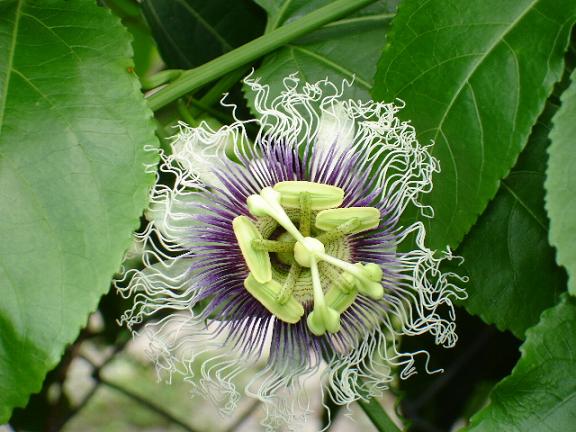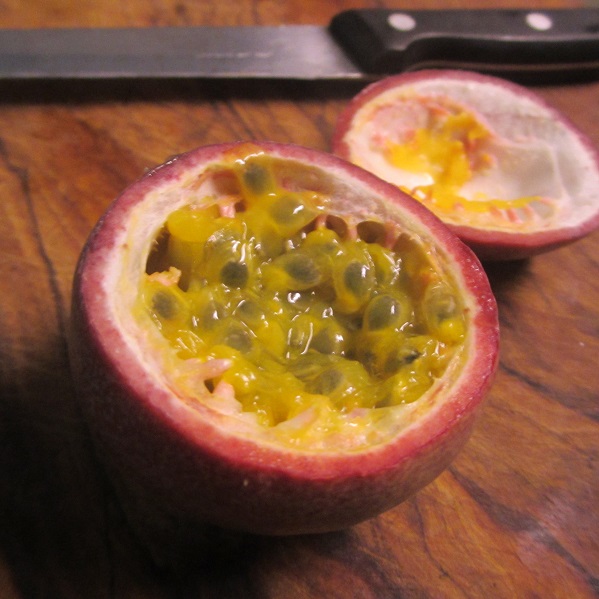Passiflora Edulis
The passionfruit vine
This is the species whose deliciously fragrant pulp is used to flavor tropical fruit juice, syrups and confections. It is the most widely cultivated of the Passifloras.
I have several different cultivars of this species, including Possum Purple, Black Knight, Big Rosy, and Lilikoi.

These vines have everything that I love in a plant. They are unusual, they have beautiful flowers, fragrant flowers, beautiful foliage, delicious fruit, and they are vigorous growers. As an added bonus they will attract hundreds of butterflies to your garden.
Binomial nomenclature
Passiflora edulis
Origin
Brazil
Description
A sprawling, evergreen, tropical, vine with large, trilobed, leaves with a finely dentate margin. The petioles usually have only two false egg potuberances on them. The vine grows vigorously, and climbs using tendrils. In Spring, fragrant flowers enclosed in three leaved bracts, emerge from the nodes along the vine. They have five white petals and five white sepals, and are 2.5″-3″ in diameter. The lacy crown is purple at the base fading to white at the tips.
The flowers are followed by the development of oval, purple skinned fruit in late Spring to Early Summer. A second, less productive flowering occurs in the Fall. The fruit should never be picked off of the plant or it will have an unpleasant woody flavor. Rather, the fruit should be allowed to fall of of the vine on its own, and collected off of the ground.
The thick rind protects the pulp inside, so as long as you collect them frequently, they won’t spoil on the ground. once they fall on their own, they are ready to eat, though some cultivars will be sweeter if you allow the rind to wrinkle up a bit before eating them.

Height/Size
These vines will grow to 20′-30′ feet in length in one season. They quickly cover large sections of fences, but they will aggressively climb on anything they can get their tendrils on. They’ll race to the top of a tree faster than you’d believe possible, and cover the canopy with their vines. They have no respect for property lines, so be considerate of your neighbors when planting any Passiflora.
Temp/zone
25° F. Zone 8b or higher. They can be grown in South Florida, Southern California, and Hawaii. They will survive in Texas, Louisiana, Mississippi, North Florida, and Alabama, if given protection from frost.
Light
Full sun
Water
Keep evenly moist. Be sure to provide a deep layer of mulch around the base of the plant, and irrigate whenever the soil becomes dry.
Fertilizer
Be sure to provide young vines with plenty of nitrogen to support their rapid vegetative growth. Use a more balanced fertilizer later on to provide the phosphorus and potassium for flowering and fruit production.
Cultivation
They will tolerate a wide range of soil types, but prefer a slightly acidic soil containing large amounts of organic matter. When planting, pick a site with full sun or as close to full sun as you can provide in your yard. I like to plant them in sheltered positions, so that the base is protected from freezes, but near sunny spots so that the vines can grow into the sun.
This plant must have a large structure to grow on. A trellis won’t be big enough, and an arbor will barely be large enough. An aquaintance of mine had a dead tangerine tree in her yard, and she didn’t want to have to have to go through the ordeal of removing it. I suggested that she use it as a structure for a passionfruit. The results were amazingly successful. The dead tree seemingly came back to life with beautiful flowers and fruit.
Pests
Many species of butterflies use plants in this genus as the primary source of foood for their developing larvae. Use BT to eliminate the caterpillars.
P. edulis is also susceptible to root knot nematodes, which slowly weaken the plant. This shortens the productive life of the plant to 3-5 years in Florida. Mulch heavily around the base of the vine to inhibit nematodes, but they will eventually damage the roots no matter what you do. So that your fruit production isn’t interupted, new seedlings or cuttings should be grown and planted in a new spot, away from the original location, every couple of years. In Florida, it is best to use cuttings, since there are native passiflora species that can hybridize with P. edulis, resulting in lower fruit quality.
Mites frequently attack the tender new foliage, causing it to become dimpled and misshapen. Malathion will control this. Sevin and imidacloprid will not control mites, and will actually cause them to reproduce faster.

Before My husband died, he and I had several of these Passion Vine plants and Loved them. We would set outside and watch them open and close, for hours at a time! Now, all the plants are gone… I orders some clippings from a woman on eBay several weeks ago for $12.00 but none of them took… Now I want to try again with you ! Although, I have never had any Passion Vine that bore the fruit, so this time I am hoping I can try raising the fruit ! I live in South Alabama, near the Florida State line, not far from Panama City Beach, we seldom get below 30 degrees here but if we do it may only last for 2 or 3 hours…but we are certainly WARM.. 100 degrees tomorrow, 97 today…. I am praying I am Glad that I found you on YOUTUBE! HAhhahahah ! I am going to share with my 77 yr old neighbor, (once I get one started good !) she also loved our Passion vines when we had them… Thanks, Cindy
Would this be suitable for growing in a large pot,,? I am in Arkansas zone 7b.
Yes it can be grown in containers
I live in zone 9a in NE Florida – Neptune Beach (east of Jacksonville, FL). We are 3 houses off the ocean. We have somewhat of a protected micro-climate around our pool. Do you think a passiflora edulis could do well in a container & trained to grow up a large trellis? (I had a passion fruit plant growing up it & it was nuts but I just pruned it & kept it somewhat under control) I don’t know if the salt air would bother it & if it would thrive in a large container…?? thank you!! Also – I bought one at a local store – it was purple & delicious. I don’t know which variety I would need – but if there is one that you recommend & that tastes really good – that would be great.
They can be grown in a container, but they won’t be as vigorous or produce as much fruit. You had a Passiflora edulis edulis. For fruit that tastes like that, either the purple variety or the yellow (Passiflora edulis flavicarpa) will work.
Hello,
When are you more Passiflora edulis “Big Rosy? Interest in purchasing 2 or 3.
I am also looking for mongosteen plant, do you have any?
Let me know
Thanks
Tony
I’ll have some new cultivars of Passiflora edulis soon. They are shaping up to be even better performers than Big Rosy.
I’m working on mangosteen relatives (genus Garcinia) now, but not Garcinia mangostana. I’ve got quite a few different species. Once they start producing, I’ll offer them for sale.
When is the best planting time? Young Vine
I like to plant in early Spring.